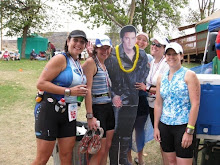To lessen your aches and pains, choose your running surface wisely.
By Jenny EverettFrom the October 2009 issue of Runner's World
The impact of running has its benefits: It builds bone and muscle strength. But it also has drawbacks: Each footfall sends strong forces up the leg with the potential of aggravating trouble spots. Luckily, runners can sidestep injuries by changing up their workout surfaces, says exercise physiologist and marathoner Tom Holland of Darien, Connecticut. "In the same way that you vary your mileage and intensity—short one day, long the next; hard one day, easy the next—you should also vary the terrain that you run on to minimize risk of injury," he says. If you're prone to shinsplints, for example, pounding the asphalt six days a week could cause a flare up. Mix in a trail or treadmill run here and there, and you could avoid a setback. Follow this guide to running grounds to log your miles safely.
Asphalt Roads
RUN FREELY: If you're not particularly injury prone and not rehabbing an injury—although Achilles tendinitis becomes less aggravated on asphalt's stiff surface, which keeps the Achilles in a shorter, less-tensed position.
TREAD LIGHTLY: If you've recently had shin or knee pain, or a fracture, muscle pull, or iliotibial-band syndrome (ITBS). Asphalt can rattle bones, joints, muscles.
Dirt Trail
RUN FREELY: If you've struggled with runner's knee, ITBS, shinsplints, or any injury aggravated by impact. Just be wary of technical trails that cause your feet to land at an angle.
TREAD LIGHTLY: If you've had an ankle sprain. The ligaments of that joint never recover 100 percent. That increases your risk of a repeat sprain, which is more likely to occur on soft, uneven surfaces.
Sand
RUN FREELY: Rarely. Sand is unstable and puts a ton of torque on the knee, ankle, and hip. That said, this surface requires the strength of muscles that are often neglected so it can be beneficial for strength building. Just keep the runs short.
TREAD LIGHTLY: If you have a history of ankle sprains or Achilles tendinitis. A 2008 study found that running on sand increases the risk of Achilles pain tenfold.
Synthetic Track
RUN FREELY: If you're prone to ankle sprains or just recovered from a fracture. The surface is predictable with no roots or curbs to trip over. It's also more cushiony than asphalt, but not so soft as to cause instability.
TREAD LIGHTLY: If you've had ITBS or calf strains. Your outside calf is shortened as you circle your way around. Tight corners can also stress your inside leg's ITB.
Grass
RUN FREELY: If you have knee pain or are returning to running after a fracture. On grass, the bulk of the energy from your footfall goes into the ground instead of reverberating back up your leg.
TREAD LIGHTLY: If you're prone to plantar fasciitis. You're more likely to overpronate on this soft, uneven surface, which puts extra torque on the ligament that runs along the bottom of your foot.
Treadmill
RUN FREELY: If you're recovering from injury or are increasing mileage and want a break from asphalt. The belt's cushioned surface reduces stress to your back, hips, knees, and feet. And it's a clear path free of obstacles.
TREAD LIGHTLY: If you're training for a road race. Running exclusively on a treadmill won't prepare you to navigate uneven terrain or cope with the impact of asphalt, and that could lead to injury.
Athletes who do plyometric drills on sand improve their sprinting ability compared to those who train on grass.





















No comments:
Post a Comment